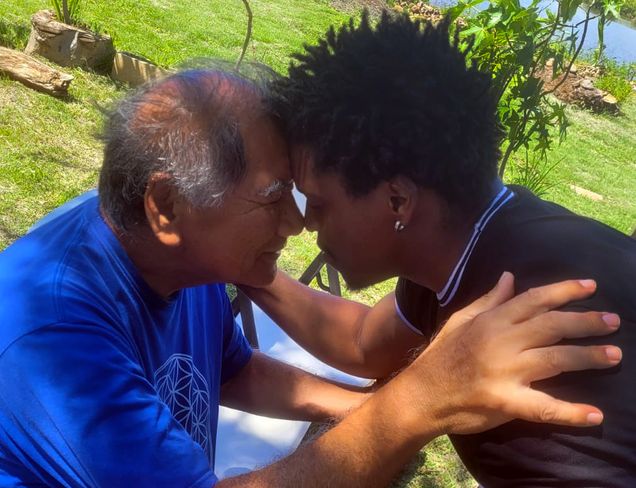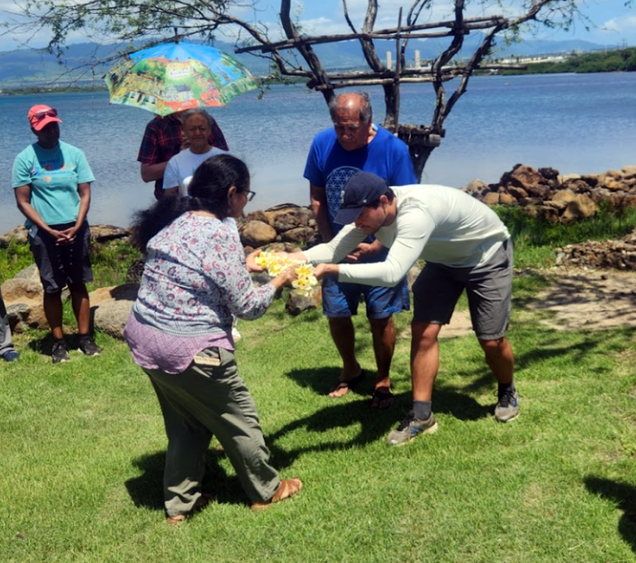BUSTH Travel Seminar explores Hawai’ian culture and religious history

By Madison Chau (’24). Photos courtesy of Madison Chau and Philip Kirui (’24).
On May 21, 2024, STH faculty members Choi Hee An, Cristian De La Rosa, and Charlene Zuill led students and staff on a travel seminar to Honolulu, Hawai’i. With a focus on postcolonial and decolonial theory and methodologies, the group had a chance to study the indigenous Hawai’ian religious history and culture, as well as the Asian immigrant history in the Hawai’ian context.

Upon arrival, they were welcomed by ministerial staff from Wesley United Methodist Church, a congregation that has played a central role in the UMC’s Acts of Repentance Task Force, which, as of April 2024, is leading the UMC in a charge to repent for Methodist missionaries’ role in overthrowing the Hawaiian kingdom. Throughout the week, the group had the opportunity to meet with the ministers, elders, and activists leading the task force and learn more about the UMC’s efforts to repair the harm caused by the illegal overthrow of Queen Liliʻuokalani’s throne. Two ministers, Rev. Piula Alailima and Rev. Amy Wake, shared about their work with the task force, and Rev. Piula talked about his efforts to incorporate his own Polynesian spirituality into Methodist worship as a form of resistance. The group participated in a sunrise chant and also attended a Sunday worship service led by Rev. Piula, who later invited them to join him in a morning oceanside ritual of chanting, song, communion out of a coconut, breakfast, and a swim.

In addition to learning about the history of Christian missionary work, the group also learned about the profound connection between Hawaiian spirituality and care for the land, or ‘āina, which they learned translates to “that which sustains life.” During a visit to Loko I’a Pā’aiau Fish Pond, the group was led by Hawaiian elders in a native Hawaiian protocol, in which each member made offerings to the ahu (altar of rocks) in gratitude for the abundance of the sea. Volunteers at the fish pond, which once fed generations of Hawaiian people before being overtaken by invasive species, are working to restore the pond, and the group spent the afternoon working alongside them and learning more about native Hawaiian plant life. At Kapi’olani Community College, they heard from Dr. Miku Lenentine, a researcher who coordinates programs that equip young adult leaders to lead community resilience efforts in the face of climate change.

In between their contextual learning sessions, group members presented on different readings to help put their experiences into historical context, with topics ranging from decolonial methodologies to Asian settler colonialism. They also had some time to go hiking and tour different historical sites, such as Iolani Palace, Bernice Pauahi Bishop Museum, Hawaii’s Plantation Village, Byod-In Buddhist Temple, and the Center for Korean Studies at the University of Hawaii Manoa. For Memorial Day, they attended a Budddhist lantern lighting ceremony honoring the victims of war, climate change, and settler colonialism, where over 8,000 people came to light lanterns for peace. After stumbling upon a native-owned Hawaiian bookstore, head librarian Amy Limpitlaw granted students their greatest wish: helping her pick out books for the STH library collection.
They returned on May 31st invigorated by their newfound understanding of the spirit of aloha, which is not only a greeting, but a way of life; “alo” translates roughly to “presence,” while “ha” means “breath.”
The trip ended with dinner at the beach, where the group reflected on their experiences. Students expressed a desire for solidarity with the Hawaiian people still living with the ongoing effects of settler colonialism, a renewed excitement to locate the resistance efforts in their own postcolonial contexts, and a deeper appreciation for the land that sustains them. They returned on May 31st invigorated by their newfound understanding of the spirit of aloha, which is not only a greeting, but a way of life; “alo” translates roughly to “presence,” while “ha” means “breath.” Aloha, then, is the breath of life—the collective spirit of love and harmony in which all of creation is called to partake.
